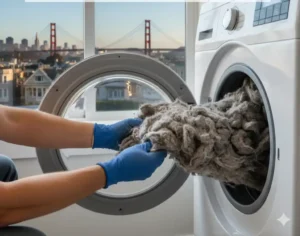Garbage disposals are unsung heroes of the modern kitchen, effortlessly grinding food scraps and keeping sinks clear. However, without proper care, these appliances can clog, emit odors, or fail prematurely, leading to costly repairs or replacements. A well-maintained garbage disposal can last 8–15 years, depending on usage, quality, and maintenance routines. In this comprehensive guide, we’ll share expert tips to maximize your garbage disposal’s lifespan, optimize performance, and avoid common pitfalls. Plus, we’ll explore the benefits of timely repairs and when to call a professional for help.
Why Garbage Disposal Maintenance Matters
A garbage disposal is more than just a convenience—it’s a critical component of your kitchen’s plumbing system. Neglecting maintenance can lead to clogs, foul odors, dull blades, or motor burnout, which can disrupt your daily routine and strain your budget. Regular care not only extends the appliance’s life but also ensures it operates efficiently, reduces environmental impact by minimizing landfill waste, and keeps your kitchen hygienic.
By following the maintenance tips below, you can avoid frequent repairs, save money, and enjoy a smoother kitchen experience. Let’s dive into the best practices for keeping your garbage disposal in top shape.
Top 10 Garbage Disposal Maintenance Tips for Longevity
1. Always Run Cold Water During and After Use
Cold water is your garbage disposal’s best friend. It solidifies grease and fats, making them easier to grind and flush through the system. Run cold water for 10–20 seconds before, during, and after operating the disposal to prevent clogs and ensure all debris is cleared from the drain. Hot water, on the other hand, can melt fats, causing them to stick to blades and pipes, leading to buildup.
2. Avoid Problematic Foods and Substances
Not everything belongs in a garbage disposal. Avoid fibrous, starchy, or hard items that can jam or dull the blades, such as:
- Fibrous foods: Celery, corn husks, banana peels, and potato skins can tangle around blades.
- Starchy foods: Pasta, rice, and oatmeal expand in water, causing clogs.
- Hard items: Bones, fruit pits, and shellfish shells can damage blades or motors.
- Grease and oils: These solidify in pipes, leading to blockages.
Instead, compost these items or dispose of them in the trash to protect your disposal’s components.
3. Clean Regularly with Natural Ingredients
Regular cleaning prevents odor-causing buildup and keeps blades sharp. Once a week, try these natural cleaning methods:
- Ice and rock salt: Fill the disposal with ice cubes and ½ cup of rock salt. Run the disposal with cold water to scrub away debris and sharpen blades.
- Baking soda and vinegar: Pour ½ cup of baking soda into the disposal, followed by 1 cup of vinegar. Let it fizz for 5–10 minutes, then flush with hot water (only when not grinding).
- Citrus peels: Grind lemon, orange, or lime peels to deodorize and freshen the disposal.
Avoid harsh chemical cleaners like bleach or drain cleaners, as they can corrode metal parts and damage the disposal over time.
4. Run the Disposal Regularly
Even if you don’t have food scraps to grind, run your garbage disposal with cold water at least once a day. This prevents rust and corrosion on the blades and keeps the motor lubricated. Regular use also dislodges minor buildup, reducing the risk of clogs.
5. Cut Large Food Scraps into Smaller Pieces
Overloading your disposal with large food chunks can strain the motor and jam the blades. Before feeding scraps into the disposal, cut them into smaller, manageable pieces and add them gradually. This ensures smooth grinding and prevents overheating.
6. Avoid Overfilling the Disposal
Stuffing too much waste into the disposal at once can overwhelm the motor and cause jams. Feed food scraps slowly and in small batches, allowing the disposal to process each portion before adding more. This simple habit can significantly extend the appliance’s lifespan.
7. Sharpen Blades Periodically
Contrary to common belief, garbage disposal blades (or impellers) don’t stay sharp forever. Grinding ice cubes or small, soft bones (like fish bones) can help maintain their edge. Perform this maintenance monthly to ensure efficient grinding and prevent jams.
8. Check for Leaks and Jams
Regularly inspect your garbage disposal for signs of wear, such as leaks under the sink or unusual noises. If the disposal hums but doesn’t spin, it may be jammed. Turn off the power, use a hex key to manually rotate the grinding plate, or use pliers to remove obstructions. Never stick your hand inside the disposal.
9. Reset the Unit When Needed
If your disposal stops working, check the reset button (usually red) on the bottom of the unit. Press it to reset the motor after clearing any jams. Frequent resets may indicate a failing motor, so monitor the unit’s performance.
10. Schedule Professional Maintenance
Annual inspections by a licensed plumber can catch potential issues early, such as worn seals, loose connections, or motor problems. Professional maintenance ensures your disposal operates at peak performance and can extend its life beyond the average 8–15 years.
Benefits of Garbage Disposal Repair
Repairing a malfunctioning garbage disposal offers several advantages:
- Cost Savings: Fixing minor issues like jams, leaks, or dull blades is often cheaper than replacing the entire unit, which can cost $100–$600 depending on the model.
- Extended Lifespan: Timely repairs can add years to your disposal’s life, delaying the need for a costly replacement.
- Improved Efficiency: Repairs restore optimal performance, reducing grinding time and preventing clogs.
- Environmental Impact: Repairing instead of replacing reduces waste and supports sustainable living.
- Hygiene: A repaired disposal eliminates odors and bacteria buildup, keeping your kitchen clean.
For professional repair services, visit our Garbage Disposal Repair page to schedule an appointment and keep your kitchen running smoothly.
When to Call a Professional
While many maintenance tasks are DIY-friendly, certain issues require expert intervention:
- Persistent Leaks: Leaks from the bottom of the unit often indicate worn seals or cracks, which need professional repair.
- Motor Failure: If the disposal hums but doesn’t grind or frequently trips the reset button, the motor may be failing.
- Electrical Issues: Flickering power or failure to turn on could signal wiring problems, which are unsafe to handle without expertise.
- Frequent Jams or Clogs: Recurring issues despite proper use may indicate internal damage or improper installation.
- Unusual Noises: Grinding or rattling sounds could mean damaged blades or foreign objects stuck inside.
A licensed plumber can diagnose and fix these problems efficiently, ensuring your disposal is safe and functional. Don’t wait for a small issue to become a major headache—contact a professional for prompt service.
Common Garbage Disposal Myths Debunked
- Myth: Hot water is better for grinding.
Truth: Cold water solidifies grease for easier grinding, while hot water can cause fats to stick to pipes. Use hot water only for cleaning when not grinding. - Myth: Eggshells and coffee grounds sharpen blades.
Truth: These items can clog pipes and don’t effectively sharpen blades. Stick to ice or citrus peels for maintenance. - Myth: Baking soda and vinegar unclog drains.
Truth: While great for cleaning, this combo is ineffective for unclogging and may cause buildup if not flushed properly. - Myth: Garbage disposals need lubrication.
Truth: Disposals are self-lubricating through regular use with water and food scraps. No additional lubrication is required.
FAQs About Garbage Disposal Maintenance
1. How can I extend the life of my garbage disposal?
Run cold water during and after use, avoid problematic foods, clean regularly with natural ingredients, and schedule annual professional maintenance to catch issues early.
2. What is the life expectancy of a garbage disposal?
With proper care, most garbage disposals last 8–15 years. Premium models like InSinkErator may exceed 15 years with diligent maintenance.
3. Is it okay to pour boiling water down a garbage disposal?
Boiling water is safe for cleaning when the disposal isn’t grinding, as it loosens stuck debris. However, use cold water during grinding to prevent grease buildup.
4. How do I know when my garbage disposal needs to be replaced?
Signs include frequent jams, persistent leaks, unusual noises, a humming motor that doesn’t grind, or reduced efficiency after 8–15 years.
5. Should you always run water when using a garbage disposal?
Yes, always run cold water before, during, and for 10–20 seconds after grinding to flush debris and prevent clogs.
6. Can you put lemons in the garbage disposal?
Yes, grinding lemon or citrus peels is an excellent way to deodorize and freshen your disposal. Just avoid large quantities to prevent jams.
7. Is it bad to pour grease down the garbage disposal?
Yes, grease and oils solidify in pipes, causing clogs. Dispose of grease in a container and throw it in the trash.
Conclusion: Keep Your Garbage Disposal Running Like New
A well-maintained garbage disposal is a game-changer for any kitchen, making cleanup easier and reducing waste. By following these expert tips—using cold water, avoiding problematic foods, cleaning regularly, and scheduling professional maintenance—you can extend your disposal’s lifespan, prevent costly repairs, and enjoy a cleaner, more efficient kitchen. If issues arise, don’t hesitate to repair rather than replace, and call a professional for complex problems to ensure long-term performance.
Ready to give your garbage disposal the care it deserves? Start implementing these tips today, and visit our Garbage Disposal Repair page for expert assistance when you need it. Share your favorite maintenance hacks in the comments below, and let’s keep our kitchens running smoothly!






